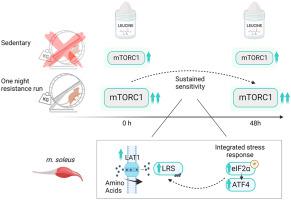客观的
运动可增强哺乳动物雷帕霉素靶点复合物 1 (mTORC1) 对氨基酸(尤其是亮氨酸)的敏感性。这种增强的敏感性能持续多久,以及哪些机制控制运动后增强的亮氨酸介导的 mTORC1 激活目前尚不清楚。
方法
经过 12 天的适应期后,C57BL/6J 小鼠在阻力制动跑轮上运动一晚。小鼠在停止运动后48小时、停食3小时后立即用次最大剂量的L-亮氨酸或盐水灌胃。亮氨酸施用后30分钟切除肌肉。为了研究 mTORC1 的贡献,我们重复了这些实验,但在过夜跑步比赛前和第一次服用亮氨酸前一小时使用雷帕霉素阻断 mTORC1 激活。使用免疫印迹和 qPCR 评估 mTORC1 信号传导、肌肉蛋白合成和氨基酸传感机制。使用L-[ 14 C(U)]-亮氨酸示踪剂标记测量亮氨酸摄取。
结果
与久坐的情况相比,补充亮氨酸可以更有效地激活剧烈运动的肌肉中的 mTORC1 和蛋白质合成。这种效应以m 为单位观察到。比目鱼肌,但不是m。胫骨前肌正常。跖肌。 m 的协同效应。比目鱼肌的效果是持久的,因为运动后 48 小时给予亮氨酸时,mTORC1 的关键下游标记物以及蛋白质合成仍然较高。我们发现运动增强了氨基酸转运蛋白的表达并促进了肌肉对亮氨酸的摄取,从而导致了更高的游离肌内亮氨酸水平。这与激活转录因子 4 (ATF4) 的表达增加相一致,ATF4 是氨基酸摄取和代谢的主要转录调节因子,下游氨基酸基因以及亮氨酰-tRNA 合成酶 (LARS)(一种假定的亮氨酸传感器)的激活也随之增加。最后,使用雷帕霉素阻断 mTORC1 并没有减少 ATF4 的表达和激活,表明后者不作用于 mTORC1 下游。相反,我们发现真核起始因子 2α (eIF2α) 磷酸化显着增加,这表明整合应激反应途径,而不是运动诱导的 mTORC1 激活,驱动运动后骨骼肌中 ATF4 的长期表达。
结论
mTORC1 对亮氨酸的增强敏感性在运动后至少保持 48 小时。这表明蛋白质摄入的合成代谢机会窗口并不限于运动后的最初几个小时。 mTORC1 对亮氨酸敏感性的增加与亮氨酸流入肌肉的增加以及参与亮氨酸感应和氨基酸代谢的基因表达的增加相一致。此外,运动还能诱导 ATF4 蛋白表达增加。总而言之,这些数据表明,肌肉收缩启动了一个协调程序,以增强氨基酸的摄取以及参与 mTORC1 激活和刺激肌肉蛋白质合成的关键氨基酸的肌内感应。
 "点击查看英文标题和摘要"
"点击查看英文标题和摘要"
Resistance exercise enhances long-term mTORC1 sensitivity to leucine
Objective
Exercise enhances the sensitivity of mammalian target of rapamycin complex 1 (mTORC1) to amino acids, in particular leucine. How long this enhanced sensitivity lasts, and which mechanisms control enhanced leucine-mediated mTORC1 activation following exercise is currently unknown.
Methods
C57BL/6J mice were exercised for one night in a resistance-braked running wheel after a 12-day acclimatization period. Mice were gavaged with a submaximal dose of l-leucine or saline acutely or 48 h after exercise cessation, following 3 h food withdrawal. Muscles were excised 30 min after leucine administration. To study the contribution of mTORC1, we repeated those experiments but blocked mTORC1 activation using rapamycin immediately before the overnight running bout and one hour before the first dose of leucine. mTORC1 signaling, muscle protein synthesis and amino acid sensing machinery were assessed using immunoblot and qPCR. Leucine uptake was measured using L-[14C(U)]-leucine tracer labeling.
Results
When compared to sedentary conditions, leucine supplementation more potently activated mTORC1 and protein synthesis in acutely exercised muscle. This effect was observed in m. soleus but not in m. tibialis anterior nor m. plantaris. The synergistic effect in m. soleus was long-lasting as key downstream markers of mTORC1 as well as protein synthesis remained higher when leucine was administered 48 h after exercise. We found that exercise enhanced the expression of amino acid transporters and promoted uptake of leucine into the muscle, leading to higher free intramuscular leucine levels. This coincided with increased expression of activating transcription factor 4 (ATF4), a main transcriptional regulator of amino acid uptake and metabolism, and downstream activation of amino acid genes as well as leucyl-tRNA synthetase (LARS), a putative leucine sensor. Finally, blocking mTORC1 using rapamycin did not reduce expression and activation of ATF4, suggesting that the latter does not act downstream of mTORC1. Rather, we found a robust increase in eukaryotic initiation factor 2α (eIF2α) phosphorylation, suggesting that the integrated stress response pathway, rather than exercise-induced mTORC1 activation, drives long-term ATF4 expression in skeletal muscle after exercise.
Conclusions
The enhanced sensitivity of mTORC1 to leucine is maintained at least 48 h after exercise. This shows that the anabolic window of opportunity for protein ingestion is not restricted to the first hours immediately following exercise. Increased mTORC1 sensitivity to leucine coincided with enhanced leucine influx into muscle and higher expression of genes involved in leucine sensing and amino acid metabolism. Also, exercise induced an increase in ATF4 protein expression. Altogether, these data suggest that muscular contractions switch on a coordinated program to enhance amino acid uptake as well as intramuscular sensing of key amino acids involved in mTORC1 activation and the stimulation of muscle protein synthesis.



































 京公网安备 11010802027423号
京公网安备 11010802027423号